
| Dr. Pill Raja and Dr. Pamela McQuillin are the first physicians in the Permian Basin area to perform a hysterectomy using the minimally invasive da Vinci Robotic System at Odessa Regional Medical Center. Please read on to learn more about robotic surgery. |
|
|||
|
|
||||
| Improved Patient Outcomes By enhancing surgical capabilities, we are helping to improve clinical outcomes and redefine standards of care. Patients may experience the following benefits: • Reduced trauma to the body • Reduced blood loss and need --for transfusions • Less post-operative pain --and discomfort • Less risk of infection • Shorter hospital stay • Faster recovery and return --to normal daily activities • Less scarring and improved --cosmesis da Vinci® Surgical System As noted by the manufacturer, the da Vinci® Surgical System consists of a surgeon console, a patient-side cart, instruments, and image processing equipment. The Surgeon Console The surgeon operates while seated at a field. The surgeon's hands are naturally positioned while his or her fingers grasp the controls below the display and movements are transferred real-time to the surgical instruments inside the patient. Patient-side Cart 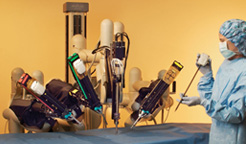 The cart consists of three robotic arms -- two instrument arms and one endoscope arm -- that execute the surgeon's commands. The laparoscopic arms pivot at 1-cm operating ports. 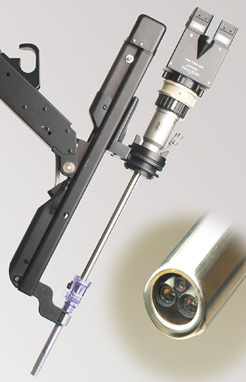 Endoscope (camera) Arm Endoscope (camera) ArmEndoWrist® Instruments  The instruments have degrees of motion that mimic the dexterity of the human hand and wrist. Each instrument has a specific surgical purpose such as clamping, suturing or tissue manipulation. 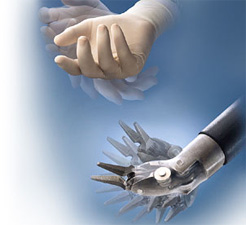 InSite® Vision System 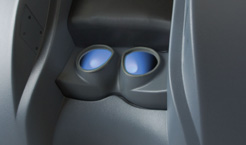 The InSite® Vision System with high resolution 3-D endoscope and image processing equipment provides 3-D images of the operative field. 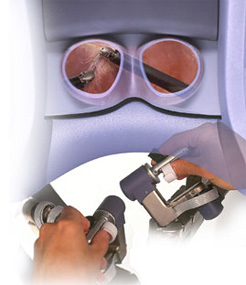 What to Expect When You Undergo Surgery Robotic surgery will require the patient to be anesthetized as she would be in traditional surgery. The patient will be taken to the OR suite, and placed under general anesthesia. The three robot arms of the da Vinci Surgical System will then be inserted through one-centimeter insertions in the patient’s abdomen. >The procedure itself will be the same as an open procedure (traditional surgery), however it will be done with minimal cutting and exposure of the abdominal cavity. The movement of the physician’s hands within the surgeon’s console will operate the arms of the Robot. He or she will have maximum rotational ability, and the instruments will very precisely mimic his movements. The length of the procedure should be similar and sometimes shorter than a traditional one, and as a result, recovery will occur at a more rapid pace. In turn, the amount of time spent in the hospital will be minimalized for the patient. Additionally, expected complications will be reduced as a result of the use of the daVinci Surgical System. |
 Gynecologic Conditions Physicians are usually successful at treating a variety of gynecologic conditions – particularly those affecting the uterus – with surgery. In spite of growing demand for minimally invasive procedures, the majority of these operations are still performed using large, abdominal incisions. These surgeries typically result in significant blood loss, and may mean several days in the hospital followed by weeks of recovery time. The daVinci surgical system has changed all that. Here's how: Hysterectomy A wide variety of conditions affect the uterus, or womb. The uterus is a hollow, muscular organ which holds and feeds a fertilized egg. Traditionally, many conditions affecting the uterus are treated with hysterectomy – the surgical removal of the uterus. U.S. doctors perform about 600,000 hysterectomies every year, making it the second most common surgical procedure. Hysterectomy may offer a life-saving treatment with serious conditions such as cancer or uncontrollable bleeding. In most cases, however, hysterectomy is an elective procedure performed to relieve chronic pain, bleeding or other disabling conditions. These may be caused by fibroids (non cancerous tumors); endometriosis (non cancerous growth of the uterine lining) or prolapse (falling or slipping of the uterus).  Traditional Hysterectomy Hysterectomy can sometimes be performed through the vagina. However, when the uterus is enlarged – for example, from fibroids or cancer – an abdominal hysterectomy is preferable. This requires a 6-12 inch incision. In some cases, doctors also remove the ovaries because they are thought to release hormones contributing to the condition.  daVinci Hysterectomy The daVinci surgical system allows the patient to avoid having a large vertical incision placed in her abdomen. Instead three 1cm incisions are made in the abdomen to insert the two daVinci surgical arms and camera into the body. 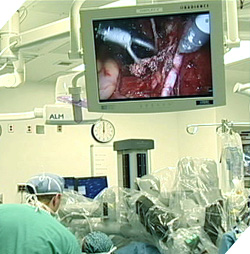 The tips of the surgical arms are fixed with tiny instruments that allow the surgeon to cut and then immediately cauterize tissue during the operation. The surgeon then detaches the uterus by slowly cutting around it and cauterizing as he or she progresses. In most cases there is very little bleeding that takes place. Sometimes, there is almost no bleeding at all. The detached uterus is removed through the vagina. After the surgical arms and camera are removed the three 1cm incisions are sutured closed. 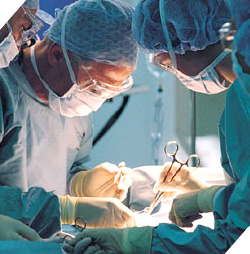 Some patients might require a short hospital stay of one or two days but most can go back to daily activities in 24 hours.  |
|||